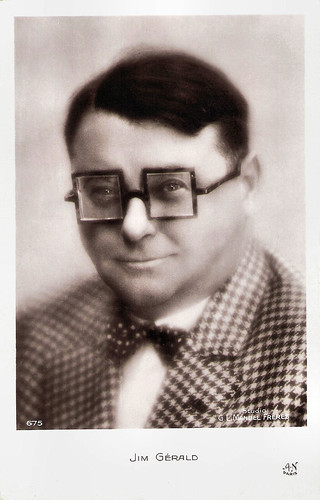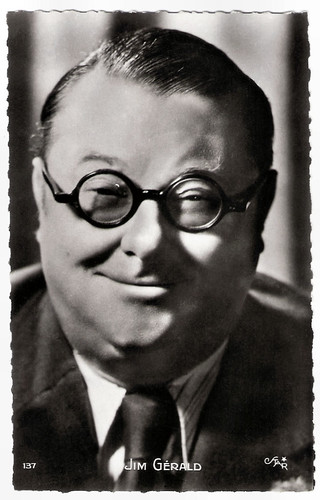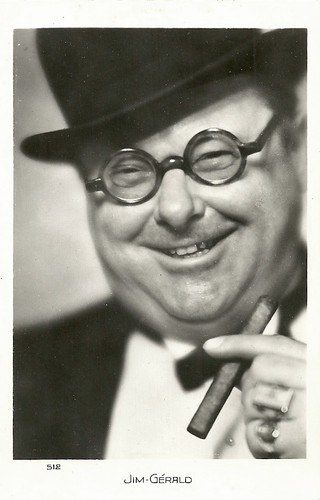
French postcard. A.N., Paris, no. 675. Photo: Studio G.L. Manuel Frères.

French collectors card by JVD (?). Photo: H. (Henri) Martinie. Henri Martinie (1885-1965) had a career particularly centred on literary circles. During the years 1920-1940, he took at his studio at the rue de Penthièvre in Paris an exceptional group of portraits of French and foreign writers, a.o. Philippe Soupault, Georges Bernanos, Jean Cocteau, Antonin Artaud, Erich Maria Remarque, James Joyce, Sylvia Beach, and Paul Eluard, but also people from the stage and screen, such as Louis Jouvet, Jean Giraudoux, Michel Simon, and Abel Gance. In addition, the Martinie Studio regularly worked at the French National Assembly, taking portraits of elected representatives and this was until the 1950s.
A regular in the films of René Clair
Jim Gérald was born in 1889 in Paris, France, as Gérald Ernest Cuénod. While Wikipedia mentions that he first acted in a short Pathé comedy, Belle-maman a mangé du cheval (1911), this title is lacking in the filmography of the official Seydoux Pathé website. Gérald started his film career more substantially in the early 1920s, parallel to a fruitful stage career with mostly George Pitoëff and later also Louis Jouvet at the Théâtre des Champs-Élysées. His first film part was that of a drunk in La légende de soeur Béatrix/The Legend of Sister Beatrix (Jacques de Baroncelli, 1923), starring Sandra Milovanoff.
Gérald became a regular actor in the films of René Clair such as Le Voyage imaginaire/The Imaginary Voyage (René Clair, 1925), La Proie du vent/The Prey of the Wind (René Clair, 1926), Un Chapeau de paille d'Italie/The Horse Ate the Hat (René Clair, 1927), and Les Deux timides/Two Timid Souls (René Clair, 1929). Gérald also acted in films by René Hervil, Henri Desfontaines, Pierre Colombier and others. Gérald had an important part as the chauffeur Jim in Le Chauffeur de Mademoiselle/Mademoiselle's driver (1928) by Henri Chomette, René Clair's brother, and starring Dolly Davis.
Jim Gérald had no problem at all changing to sound cinema around 1929, and so the number of his roles increased in the early 1930s. In 1930, he reached a peak with performances in well 10 films, including the French versions of German films by Carl Froehlich and others, such as Barcarole d'amour/Love Barcarole (Carl Froelich, Henry Roussel, 1930) and La Folle aventure/The Crazy Adventure (André-Paul Antoine, 1931).
Gérald thus often was the second male lead as in Le Chant du marin/Sailor's Song (Carmine Gallone, 1932) with Albert Prejean, and dramas such as L'Arlésienne (Jacques de Baroncelli, 1930) after Alphonse Daudet, or even the male lead in such film comedies as Ma tante d'Honfleur/My aunt from Honfleur (André Gillois, 1932) with Florelle, and Mon curé chez les riches/My parish priest at the rich house (E.B. Donatien, 1932).
He played Commissioner Lohmann in the French version of Fritz Lang's Das Testament des Dr. Mabuse, Le Testament du docteur Mabuse/The Testament of Dr. Mabuse (Fritz Lang, 1933). He acted in various early sound films by Jacques de Casembroot from 1929 on. In the mid-1930s Gérald played Cocardasse in Le bossu/The Hunchback (René Sti, 1934) starring Robert Vidalin, and the charcoal-burner in Friedrich Feher's The Robber Symphony (1936), while he also had memorable parts in Titin des Martigues/Titin from Martigues (René Pujol, 1938), Legion d'honneur/Legions of Honor (Jean Choux, 1938), and the pacifist film Paix sur le Rhin/Peace on the Rhine (Jean Choux, 1938) with Françoise Rosay and Dita Parlo.

French postcard by Editions P.I., Paris, no. 137. Photo: Star.
French without tears
During the war years, Jim Gérald's production drastically slowed down. He was a pirate in L'or du Cristabal/Cristobal's Gold (1940), a film which Jacques Becker started filming but soon was taken over by Jean Stelli, and for which Carl Koch and Jean Renoir had collaborated on script and dialogue. The film starred Albert Préjean with whom Gérald had done several films, Charles Vanel and Conchita Montenegro.
Gérald had a lead in the Swiss film Mob 39 (Arthur Porchet, 1940), while he was a French professor in French Without Tears (Anthony Asquith, 1940) starring Ray Milland. For the rest of the war years, Gérald hardly acted on screen, but he became most active again once the war was over.
He returned to the screen in Boule de suif/Angel and Sinner (Christian-Jaque, 1945) starring Micheline Presle. In the later 1940s and 1950s, Gérald often acted with director Jean Delannoy, such as in Les jeux sont faits/Second Chance (1947) based on a screenplay by Jean-Paul Sartre, but also with many directors now forgotten.
He worked with such famous directors as John Huston at Moulin Rouge (1952), Alexandre Astruc at Le Rideau cramoisi/The Crimson Curtain (1953), Julien Duvivier at L'Affaire Maurizius/On Trial (1954), Joseph Mankiewicz at The Barefoot Contessa (1954), Jean Renoir at Elena et les hommes/Paris Does Strange Things (1956), and Sacha Guitry at Si Paris nous était conté/If Paris Were Told to Us (1956).
Jim Gérald continued to act in the film until the end of the 1950s. He published two memoirs, 'Du Far-West au cinéma' (1945), and 'En roulant ma bosse' (1950). His last film was Le vent se lève/Time Bomb (Yves Campi, 1959). All in all, he acted in 135 films. Jim Gérald died in 1958 in Paris at the age of 68. He was married to Clara Albertine Kienitz.

French postcard, no. 512.
Sources: Wikipedia (French and English), and IMDb.
This post was last updated on 14 May 2024.
No comments:
Post a Comment